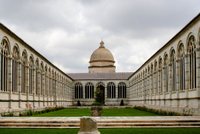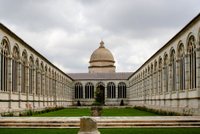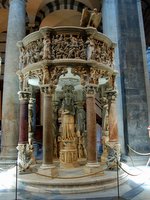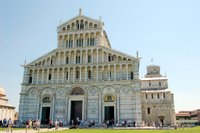 Pisa is a city in the Tuscany, best known for its Leaning Tower, the landmark of the city!
As we approached the cathedral square from the east via the Via Cardinale Pietro Maffi, we were greatly surprised by a spectacular view of this 12th-century miracle
(picture to the left).
Pisa is a city in the Tuscany, best known for its Leaning Tower, the landmark of the city!
As we approached the cathedral square from the east via the Via Cardinale Pietro Maffi, we were greatly surprised by a spectacular view of this 12th-century miracle
(picture to the left).
Cathedral Square or Square of Wonders
 The touristic heart of the city is the Cathedral Square (Piazza Duomo), popularly known as the Square of Miracles (Piazza dei Miracoli).
There you find, built in shining, white
Carrara marble, the Pisa Cathedral, the famous Leaning Tower (Campanile), the largest
baptistery
The touristic heart of the city is the Cathedral Square (Piazza Duomo), popularly known as the Square of Miracles (Piazza dei Miracoli).
There you find, built in shining, white
Carrara marble, the Pisa Cathedral, the famous Leaning Tower (Campanile), the largest
baptistery in the world, as
well as the Monumental Cemetery
in the world, as
well as the Monumental Cemetery
 (Camposanto Monumentale). The
entire ensemble is an unique example of mediaeval Christian
architecture, a monumental complex of masterpieces full of
beauty and harmony. Since 1987 the Cathedral Square has been a
UNESCO World Heritage Site.
(Camposanto Monumentale). The
entire ensemble is an unique example of mediaeval Christian
architecture, a monumental complex of masterpieces full of
beauty and harmony. Since 1987 the Cathedral Square has been a
UNESCO World Heritage Site.
The Leaning Tower
The construction of the free-standing Campanile (bell tower), the "Leaning Tower", was begun in 1173.
14,200 t of white Carrara marble were used for the magnificent tower, which has a height of 55.8 m (183 ft)
and a diameter of 12 m (39 ft)! Each floor is surrounded by a gallery with 30 columns and can be entered through a door.
In the bell chamber there are 7 bells, which are rung at noon and when a mass is held.

It is hard to believe that, despite its spectacular inclination, this structure has been able
to stand upright over the centuries and even can be climbed by visitors!
Already during the construction of the 3rd floor in 1185 one discovered that the tower had tilted.
After a break of about 100 years, with the construction of the next 4 floors, an attempt was made,
to compensate the inclination by means of a smaller inclination angle.
The cause of the inclination was, that the ground had deformed under the weight of the tower.
This process continued, however, so that the tower had to be closed from 1990
on.
For the upcoming redevelopment one found an ingenious solution:
On the north side of the tower 4 to 5 m (13 to16,4 ft) deep holes were drilled into the ground,
whereby about 50 m3 of material were removed. The plan worked - the ground slumped and
the tower was straightened by 45 centimeters (17.7 inches), returning to its 1838 position!
Thus, the imbalance of the tower was four degrees, corresponding to a deviation at the top of 3.9 m (12,8 feet) after all.
Engineers stated, that it would be stable now for at least 200 years.
Since 2001 the tower can be visited again.
Cathedral Santa Maria Assunta
 The construction of the magnificent Cathedral of Santa Maria Assunta began in 1063 and lasted for over 200 years.
It has a cross-shaped floor plan, which was unusual at the time and bears an
elliptical cupola
The construction of the magnificent Cathedral of Santa Maria Assunta began in 1063 and lasted for over 200 years.
It has a cross-shaped floor plan, which was unusual at the time and bears an
elliptical cupola
 on an octagonal pedestal above the crossing.
The spacious, gorgeous interior of the cathedral is lined with black and white marble and decorated with a gilded coffered ceiling
as well as numerous frescoes and paintings. In the middle of the building is a double row of massive granite columns with capitals.
The arcades with their black and white marble stripes are reminiscent of a mosque.
After the great fire in 1595, the cathedral was elaborately restored in the 17th century. The coffered ceiling dates back to this period,
while the pulpit
on an octagonal pedestal above the crossing.
The spacious, gorgeous interior of the cathedral is lined with black and white marble and decorated with a gilded coffered ceiling
as well as numerous frescoes and paintings. In the middle of the building is a double row of massive granite columns with capitals.
The arcades with their black and white marble stripes are reminiscent of a mosque.
After the great fire in 1595, the cathedral was elaborately restored in the 17th century. The coffered ceiling dates back to this period,
while the pulpit
 , a masterpiece from the 14th century, is still in its original form.
The beautiful west facade
, a masterpiece from the 14th century, is still in its original form.
The beautiful west facade
 with its 4 loggias and 52 columns went down in the history of architecture as Pisan Romanesque and had formative influence on the Tuscany.
with its 4 loggias and 52 columns went down in the history of architecture as Pisan Romanesque and had formative influence on the Tuscany.












